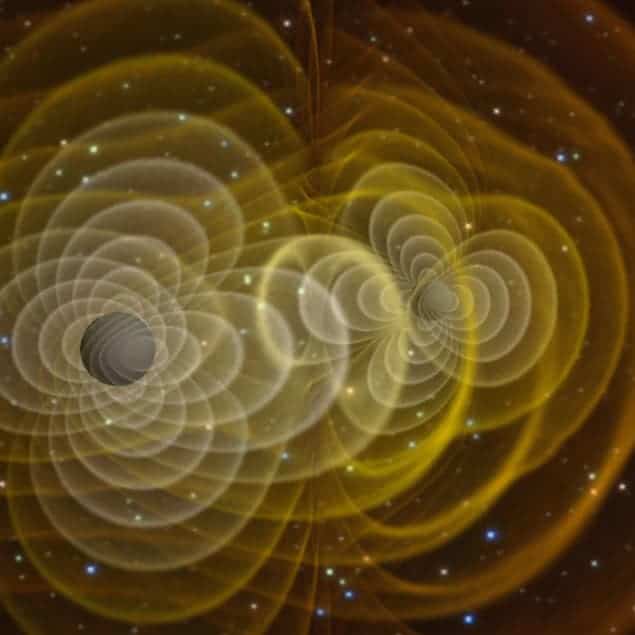
In February 2016 researchers at the Advanced Laser Interferometer Gravitational-wave Observatory (aLIGO) in the US announced a ground-breaking discovery – on 14 September 2015 they had made the first ever direct detection of gravitational waves. After decades of trying to observe these ripples in space–time, the scientists had at last addressed the final unverified prediction of Einstein’s general theory of relativity. Success was quickly followed by success and a few months later a second detection was reported.
In both cases (called GW150914 and GW151216 respectively), as well as a less statistically significant event (LVT151012), the gravitational waves were produced by two stellar-mass black holes in a binary orbit that merged to form one larger black hole. While the detection events are a significant breakthrough, they are still shrouded in mystery. “Previous to this, we never observed a black hole binary system, which leads to the natural question – how did these come to be?” says LIGO scientist Amber Stuver, who was not involved in this current work.
So far, several scenarios have been proposed but they struggle to explain all observed events under one framework. Now, however, scientists at the University of Birmingham in the UK and the University of Amsterdam in the Netherlands have developed a model that can describe all three events via one evolutionary path.
Close together
Before LIGO’s detections, it was thought that stellar-mass binary black-hole systems would either not form at all or, if they did, they would be too far apart to merge within the age of the universe. For two black holes to merge within the age of the universe, they have to begin very close together by astronomical standards – no more than a fifth of the distance between the Sun and Earth. But black holes are produced by massive stars that expand to be much larger than this distance during their stellar evolution.
To solve this problem Simon Stevenson from Birmingham’s Gravitational Wave Group and colleagues developed a simulation platform called Compact Object Mergers: Population Astrophysics and Statistics (COMPAS). “It is a tool for both predicting the evolution of massive stellar binaries and statistically comparing these predictions against observations,” explains team member Ilya Mandel.
Using COMPAS, the group propose an “isolated binary evolution via a common envelope phase”. This means that two massive stars begin with a quite wide separation. As these stars evolve and expand over time, they interact and undergo several episodes of mass transfer, the last of which is called a “common envelope”. This is a very rapid, unstable transfer that envelops both stellar cores in a dense cloud of hydrogen gas. The formation and subsequent ejection of this shared gas cloud is strong enough to take energy away from the orbit, bringing the stars close enough to merge. At this stage in their evolution, the stars are small enough in volume not to be in contact with each other despite their proximity, and they subsequently continue orbiting before merging as black holes billions of years later.
Wind loss
To reach this model, Stevenson, Mandel and colleagues had to make a series of assumptions about physical processes that govern stellar and binary evolution. For example, astronomers do not know the extent to which very massive stars expand and how much mass they lose through winds during evolution. With COMPAS, the researchers produced stellar binary models based on their assumptions and computed their statistical properties. They could then compare these predictions to the observational data and make adjustments accordingly.
“There are a lot of basic assumptions made to come to these results and many more to test,” comments Stuver, “but it is impressive that this one evolution scenario can explain all three of the gravitational wave events.”
“There are a lot of basic assumptions made to come to these results and many more to test,” comments Stuver, “but it is impressive that this one evolution scenario can explain all three of the gravitational wave events.”
As well as providing an explanation of the binary process, the simulation has also helped the team understand what type of stars can form such systems. They suggest that the massive stars have low metallicity, meaning they are almost entirely made up of hydrogen and helium. While 2% of the Sun is other elements, these massive counterparts would contain only 0.1%.
Robust framework
Writing about their proposed model, presented in Nature Communications, Mandel says that, “while [the work] doesn’t yet prove that this is indeed the dominant formation channel for forming merging binary black holes, and while this is almost certainly not the unique channel for doing so, it does allow us to build a robust framework for analysing future observations.”
The researchers hope to improve their model and figure out which assumptions are right by using data from other stellar systems, such as neutron-star binaries, supernovae and X-ray binaries. “The long-term goal is to combine all of these observations to understand how massive stars and binaries evolve,” says Mandel. “We very much look forward to further LIGO detections, and to incorporating other rich observational data sets, in order to gain a better understanding of the lives (and deaths) of massive stars.”



